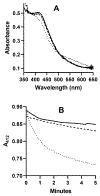Catalytic Activity of the Archetype from Group 4 of the FTR-like Ferredoxin:Thioredoxin Reductase Family Is Regulated by Unique S = 7/2 and S = 1/2 [4Fe-4S] Clusters
- PMID: 38817151
- PMCID: PMC11234629
- DOI: 10.1021/acs.biochem.3c00651
Catalytic Activity of the Archetype from Group 4 of the FTR-like Ferredoxin:Thioredoxin Reductase Family Is Regulated by Unique S = 7/2 and S = 1/2 [4Fe-4S] Clusters
Abstract
Thioredoxin reductases (TrxR) activate thioredoxins (Trx) that regulate the activity of diverse target proteins essential to prokaryotic and eukaryotic life. However, very little is understood of TrxR/Trx systems and redox control in methanogenic microbes from the domain Archaea (methanogens), for which genomes are abundant with annotations for ferredoxin:thioredoxin reductases [Fdx/thioredoxin reductase (FTR)] from group 4 of the widespread FTR-like family. Only two from the FTR-like family are characterized: the plant-type FTR from group 1 and FDR from group 6. Herein, the group 4 archetype (AFTR) from Methanosarcina acetivorans was characterized to advance understanding of the family and TrxR/Trx systems in methanogens. The modeled structure of AFTR, together with EPR and Mössbauer spectroscopies, supports a catalytic mechanism similar to plant-type FTR and FDR, albeit with important exceptions. EPR spectroscopy of reduced AFTR identified a transient [4Fe-4S]1+ cluster exhibiting a mixture of S = 7/2 and typical S = 1/2 signals, although rare for proteins containing [4Fe-4S] clusters, it is most likely the on-pathway intermediate in the disulfide reduction. Furthermore, an active site histidine equivalent to residues essential for the activity of plant-type FTR and FDR was found dispensable for AFTR. Finally, a unique thioredoxin system was reconstituted from AFTR, ferredoxin, and Trx2 from M. acetivorans, for which specialized target proteins were identified that are essential for growth and other diverse metabolisms.
Conflict of interest statement
The authors declare no competing interests.
Figures







Similar articles
-
Toward a mechanistic and physiological understanding of a ferredoxin:disulfide reductase from the domains Archaea and Bacteria.J Biol Chem. 2018 Jun 15;293(24):9198-9209. doi: 10.1074/jbc.RA118.002473. Epub 2018 May 2. J Biol Chem. 2018. PMID: 29720404 Free PMC article.
-
Structural snapshots along the reaction pathway of ferredoxin-thioredoxin reductase.Nature. 2007 Jul 5;448(7149):92-6. doi: 10.1038/nature05937. Nature. 2007. PMID: 17611542
-
The function and properties of the iron-sulfur center in spinach ferredoxin: thioredoxin reductase: a new biological role for iron-sulfur clusters.Biochemistry. 1996 Sep 3;35(35):11425-34. doi: 10.1021/bi961007p. Biochemistry. 1996. PMID: 8784198
-
Thioredoxins and thioredoxin reductase in chloroplasts: A review.Gene. 2019 Jul 20;706:32-42. doi: 10.1016/j.gene.2019.04.041. Epub 2019 Apr 24. Gene. 2019. PMID: 31028868 Review.
-
The ferredoxin/thioredoxin system of oxygenic photosynthesis.Antioxid Redox Signal. 2008 Jul;10(7):1235-74. doi: 10.1089/ars.2007.1931. Antioxid Redox Signal. 2008. PMID: 18377232 Review.
References
-
- Jacquot JP, Eklund H, Rouhier N, and Schürmann P (2009) Structural and evolutionary aspects of thioredoxin reductases in photosynthetic organisms, Trends Plant Sci. 14, 336–343. - PubMed
-
- Meyer Y, Buchanan BB, Vignols F, and Reichheld JP (2009) Thioredoxins and glutaredoxins: unifying elements in redox biology, Annu. Rev. Genet 43, 335–367. - PubMed
-
- Lu J, and Holmgren A (2014) The thioredoxin antioxidant system, Free Radical Biology and Medicine 66, 75–87. - PubMed
-
- Ramaswamy V, Boucher O, Haigh J, Hauglustaine D, Haywood J, Myhre G, Nakajima T, Shi GY, and Solomon S (2001) Radiative forcing of climate change, In Climate Change 2001: The Scientific Basis. Contribution of Working Group I to the Third Assessment Report of the Intergovernmental Panel on Climate Change (Houghton JT, and Ding Y, and Griggs DJ, and Noguer M, and van der Linden PJ, and Dai X, and Maskell K, and Johnson CA, Eds.), pp 349–416, Cambridge University Press, Cambridge, U. K.
Publication types
MeSH terms
Substances
Grants and funding
LinkOut - more resources
Full Text Sources

